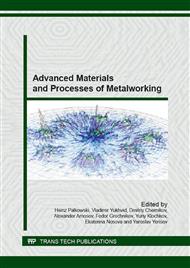[1]
Antonov G.A. Bases of standardization and production quality management: 3 EA / G.A. Antonov. – St. Petersburg: Publishing house СПбУЭФ,. – P. 1. – 1995. – 145 page: ill.
Google Scholar
[2]
Bargesyan, A.A. Formation of system of risks management on factories of automobile industry / A.A. Bargesyan, Author's summary of a dissertation for a competition for a degree of a Candidate of economical sciences. – St. Petersburg, (2011).
Google Scholar
[3]
National State Standard ISO 9001-2011. A system of quality management. Requirements. – Introduction 2013-01-01. – M.: Стандартинформ, 2012. – 36 page.
Google Scholar
[4]
Ostapenko, M.S. and D.S. Vasilega, 2013. Method of Evaluation of Quality of Metal-Cutting Tool. Applied Mechanics and Materials, #379: 49-55.
DOI: 10.4028/www.scientific.net/amm.379.49
Google Scholar
[5]
Artamonov E.V., Ostapenko M.S. and D.S. Vasilega, 2013. Improvement of efficiency of modular tooling systems application based on qualimetric evaluation. World Applied Sciences Journal, Volume 25, Issue 9, 2013, Pages 1275-1279.
Google Scholar
[6]
Artamonov E.V., Vasilega D.S. and M.S. Ostapenko, 2015. Methods of Considering Reliability in the Quality Evaluation Procedure for Composite Metal Cutting Tools. Applied Mechanics and Materials Vol. 770 (2015) pp.216-220.
DOI: 10.4028/www.scientific.net/amm.770.216
Google Scholar
[7]
E.V. Artamonov, D.V. Vasil'ev Determining the optimal cutting speed in turning by composite cutters on the basis of the chip. Russian Engineering Researh. – 2014, Volume 34, Issue 6, pp.404-405.
DOI: 10.3103/s1068798x14060069
Google Scholar
[8]
Artamonov, E.V., Vasilega, D.S., Tveryakov, A. M Determining the maximum-performance temperature of hard-alloy cutting plates Russian Engineering Research 2014, 34 (6), pp.402-403.
DOI: 10.3103/s1068798x14060057
Google Scholar
[9]
Astakhov, V.P. and M.O.M. Osman, 1996. Correlations amongst Process Parameters in Metal Cutting and their Use for Establishing the Optimum Cutting Speed. Journal of Materials Processing Technology, #62: 175-179.
DOI: 10.1016/0924-0136(95)02225-2
Google Scholar
[10]
Artamonov, E.V., Vasilega, D.S. and A. M Tveryakov, 2015 Increasing Machining Efficiency of Components Made from Hard-Processing Materials. Applied Mechanics and Materials Vol 770 (2015) pp.34-39.
DOI: 10.4028/www.scientific.net/amm.770.34
Google Scholar
[11]
Shalamov, V.G., Savel'ev, D.A., Smetanin, S.D. Producing powder by rotary grinding. Russian Engineering Research 33 (3), pp.133-135, (2013).
DOI: 10.3103/s1068798x13030167
Google Scholar
[12]
E.V. Artamonov, V.V. Kireev Effectiveness of cutting by hods with replaceable hard-alloy plates. Russian Engineering Research July 2014, Volume 34, Issue 7, pp.473-474.
DOI: 10.3103/s1068798x14070053
Google Scholar


